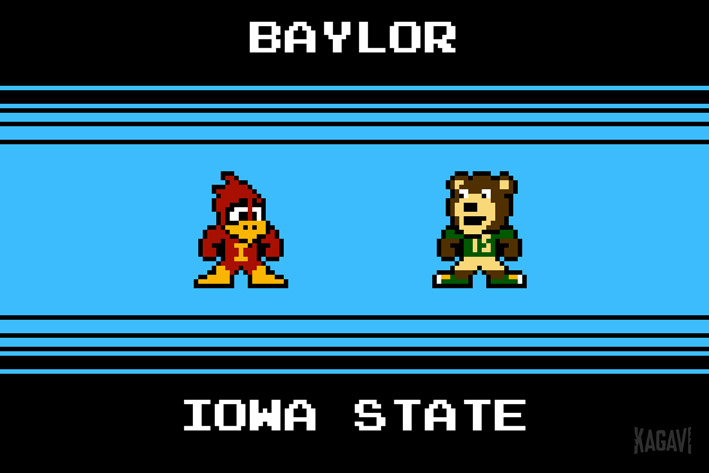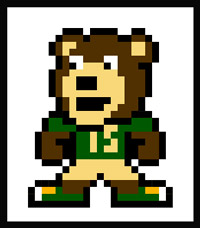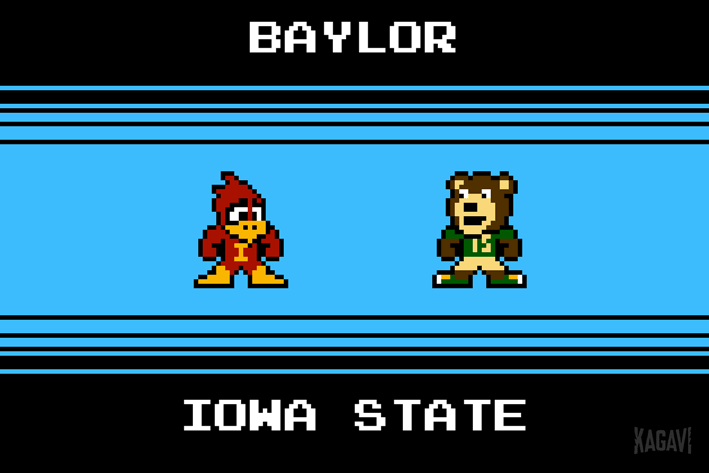
(Story originally posted on SB Nation’s ISU site: Wide Right & Natty Lite.)
_____________
WRNL is proud to present nine weekly articles from Kagavi leading up to the official release of The Adventures of Robot Cy, a fictional 8-bit video game trailer that never was.
In a faraway futuristic time, college football has been taken over by robot mascots. Join Robot Cy as he travels through many thrilling levels to find out who is behind this nefarious plot!
Every week during the conference season, Kagavi will preview the ISU football game using this project as inspiration by asking what power ups could Robot Cy gain by defeating the other Big 12 robot mascots?
_____________
In a decent effort against TCU last week, the Iowa State football team looked like they were cooking up a vintage Rhoads upset, but sadly fizzled in the second half. Robot Cy had a better weekend, picking up the coveted Ice Freeze power up from Super Frog. This Saturday, the Cyclones will travel to Waco to face off against #2 Baylor and their spinning slot machine offense. Last week, Baylor beat West Virginia 62 – 38 behind another superlative effort from human glitch Corey Coleman, Baylor’s star wide receiver. The last time ISU played in Waco, the Bears eased by 71 – 7, but not before a furious ISU comeback with three minutes left eventually ran out of time. Last year, the game was closer but still another ISU loss: 49 – 28.
But what if Robot Cy was facing off against Robot Bruiser?
If Robot Bruiser used the best parts of Baylor football history to inspire a power up, what would it be? Let’s explore some Baylor history.

Baylor was formed as a Baptist college in 1845, and it is the oldest university in Texas–created just before the Republic of Texas joined the United States as the 28th state. (It would take nearly 30 to 40 years for TCU, Texas A&M, and Texas to emerge.) Along with many other schools, Baylor started playing football in the last decade of the 1800s, but it wasn’t until 1914 that Baylor became a founding member of the nascent Southwest Conference.
Prior to the Big 12 being formed, ISU had only played Baylor once in 1988, which was a 35 – 0 Bears win in Ames. Currently, the series stands at 7 wins and 6 losses in favor of Baylor. The Iowa State game this year is Baylor’s homecoming and I thought it was pretty cool that the homecoming tradition of parades, pep rallies, and a big football game apparently started with Baylor in 1909, trumping the 1911 Missouri claim that has been credited elsewhere.
In 1914, the students voted on a school nickname, with Bears winning over such intimidating choices as Bookworms, Ferrets, and Frogs. In short order, a live bear was added and there have been actual bears roaming the campus for nearly 100 years now. The addition of a costumed mascot, Bruiser, is fairly recent. Many fans are fond of the original logo known as Sailor Bear, which was created by artist Arthur Evans for Angelus Pacific in the 1950s. (Evans is an interesting story–he created many mascots for college teams, including the Purdue Boilermaker, Florida Gator, and Oregon State Beaver.)
Another neat tradition is Baylor’s annual Diadeloso celebration, which is similar to Veishea (RIP). Although the tradition dates back to 1932, it wasn’t until 1966 that the student body voted to start using the Diadeloso name, meaning “the day of the bear.” Given this Mexican-influenced theme, we nearly had the power up as a Sugar Bear Skull.
The Baylor football program had a solid start with four Southwest Conference titles in 1915, 1916, 1922, and 1924. In subsequent decades, they bounced all around the standings, but when the 1960s rolled around, the program found itself cratering with a prolonged streak of last place (or near-last place) finishes. The putrid 1969 squad was Baylor’s worst season in school history–they finished 0 – 10.
When Coach Grant Teaff joined the program in 1971, the next few years weren’t much better with two more last place finishes and a near last place finish. Disco Fever was starting to sweep the nation when the 1974 season rolled around and observers didn’t expect much from Coach Teaff’s squad in his fourth year. Preseason polls had them in last place and the brutal schedule didn’t help matters any. The opening game saw Baylor lose a tough one against #1 Oklahoma, who would go on to win the national championship.
When the Texas game rolled around in November, the Bears faced a 24 – 7 deficit at halftime, along with the knowledge that they had never beaten Texas coach Darrell Royal in 17 tries. Texas would not score in the second half and Baylor prevailed 34 – 24. Stunned fans dubbed the game (and by extension, the season) the Miracle on the Brazos. The Bears went on to win the conference for the first time in 50 years, and played in the Cotton Bowl.
A few years later, Mike Singletary arrived on campus and his senior All-American season in 1980 saw the Bears win the Southwest Conference again and set a school record for wins that stood for many decades. Coach Teaff retired after the 1992 season and the Baylor program plunged into another prolonged period of mediocrity, only to be saved by a Texan named Art Briles.
When Coach Briles took over, a key tenet of his rebuild was going after “guys who were trailblazers and had a tremendous amount of independence about them that wanted to make a change.” This meant flashy uniforms and a trendy offense designed to rack up large amounts of points. “In this age, everything is visual . . . Kids see us, with our stadium and uniforms and style of play, and they like it,” Briles said. “Everywhere I go across the state and nation, the No. 1 theme with recruits and fans is Baylor has the best unis.”
Perhaps the perfect manifestation of Briles’ reclamation project was quarterback Robert Griffin III, the smiling, dreadlocked slinger who won the Heisman Trophy in 2011. His flashy play matched perfectly with Baylor’s meteoric rise through the Big 12 ranks.
Thus, after this brief look at Baylor history, it only seems appropriate that the power up for Robot Bruiser should come with a way to get out of last place as well as utilizing the glittery flashiness that is a signature part of the current Baylor football team identity. When the 1974 team won the SWC championship, Disco Fever was sweeping the country. The disco ball was originally patented as a mirror ball in 1924 (during yet another Baylor championship season) and it’s a perfect encapsulation of Coach Briles’ overall philosophy.

The Disco Balls power up gives Robot Cy the sorely needed ability to razzle-dazzle his way into an entirely unexpected conference title after many years in last place. Satisfying long-suffering fans, this power up also comes with multiple flashy uniform changes to help recruiting and bring home a fancy trophy or two (paging Seneca Wallace). If Robot Cy had access to this power up, what historical football (or basketball) seasons could have turned out much differently?
Are there any other possible power ups that would fit Robot Bruiser? Share them in the comments!
_____________
Visit Kagavi.com or follow them on Twitter at @Kagavi to keep up on all of their projects, including the celebrated Jack Trice series.
